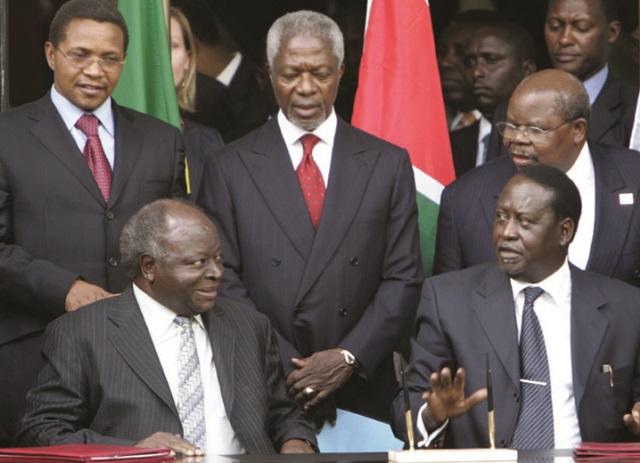
Lessons from Kibaki for Uganda, Rwanda, Burundi
ANALYSIS | JM KAVUMA-KAGWA | February, 2013 | Uhuru Kenyatta, the son of Kenya’s founding president, Jomo Kenyatta, and Raila Odinga, the son of his Vice President, Jaramogi Oginga Odinga, are contesting in the March 4 Kenyan General Election to succeed President Mwai Kibaki.
The election will be significant because it will mark the handing over of the mandate to lead Kenya to a younger generation, and will test the maturity of the multiparty that Kenyans have practiced since 1992.
It will be the third time that the presidency will be transitioning to a new generation of Kenyans. If the founding president, Kenyatta, were alive today, he would be 120 years and his vice, Oginga Odinga would be 102 years. That is the first generation. The outgoing president, Kibaki; who is 81, represents the second generation. Raila Odinga, who is 68 years old, and Uhuru Kenyatta, 61, are the third generation leaders.

In the 50 years of its independence, Kenya has had three Presidents: Jomo Kenyatta (15 years), Daniel arap Moi (24 years) and Mwai Kibaki (10 years).
In the region, only Tanzania has also successfully transferred power in peaceful democratic elections over generation, albeit to members of the same party, Chama Cha Mapinduzi. There next election is in 2015 and it can be safely predicted the President Jakaya Kikwete, who will be 55 then, will give way to somebody else.
The same prediction cannot be made about Burundi where President Pierre Nkurunziza, who has been in power since 2005, faces an election in 2015. Burundi has been the most unstable of all the East African countries. It has endured the most coup d’état as Hutu and Tutsi battle for supremacy.
Uganda has an election scheduled for 2016. Although it has been relatively stable since President Yoweri Museveni came to power in 1986, it has not experienced a peaceful transfer of power.
The same can be said of Rwanda where President Paul Kagame’s RPF has been in power since 1994. President Kagame, who came to power in 2000 and won a second seven-year term in 2010, is constitutionally barred from contesting in the scheduled election in 2017.
The East African newspaper reported this month that President Kagame has named a three-man team to create a “transition formula”. According to the paper, the formula is supposed to deliver “change, continuity, and stability”. There is uncertainty in the Kigali formula also.
Constitutionalism
Not so in Kenya where it is almost certain that after the March 4, 2013 General Elections the President of Kenya will either be Uhuru Kenyatta or Raila Odinga.
The elections should have been held in August 2012 but were postponed by a High Court ruling to March 2013 to enable parliament to complete its five-year term under a new constitution.
The Federal System Constitution adopted on August 4, 2010 under which the March 4, 2013 General Elections will be held marks a milestone in Kenya’s politics of compromise and constitutionalism.
Kenya has maintained political stability through power sharing arrangements that revolve around the two big tribes; Kenyatta’s Kikuyu and the Luo of Odinga.
The power has benefited the Kikuyus more because it resulted into making a Federal System Constitution which gives political autonomy to each region. They chose to call them Counties. There are 47 Counties.
The new Constitution is good for all tribes, especially the Kikuyus, because it has tribal safeguards. It is designed in such a way that counties aka tribes can plan for their economic, social and educational development and a President from another county cannot constitutionally sabotage them.
The Kikuyus fought for Kenya’s Independence and they have built Kenya and right now they control 60% of Kenya’s economy. What is most remarkable is that they have all along cooperated with the other tribes and the neighbouring countries, to build Kenya.
The Kikuyus were lucky that the Independence President was Jomo Kenyatta who came with the best philosophy of “Harambee” and built a firm economic foundation for his people within the 15 years he ruled Kenya. Harambee means that, “Let all the tribes of Kenya unite together to build a strong Nation”.
The young generation comprises the sons and daughters of the old guard who fought and liberated Kenya after a “bitter” Mau Mau war of Independence. Independence was achieved on December 12, 1963. The last of the old guard is Kibaki, who has led Kenya for ten years.
The founding father, Kenyatta, did not have much time to groom his son Uhuru because he died in 1978 when Uhuru was only 17 years old. But Uhuru has been lucky; he has been groomed by President Mwai Kibaki, a political genius and a first class Economist. His mother, Mama Ngina Kenyatta has also played a big part in preparing her son, assisted by the Kikuyu Elders of GEMA (Gikuyu, Embu and Meru Association) who included the late rich man James Njenga Karume and John Michuki and the descendants of the late Senior Chief Koinange of Kiamba, in Kiambu County.
Jaramogi Oginga Odinga groomed his son Raila to be a future leader of Kenya and by the time he died in 1996 Raila had already fully acquired the political muscle to forge ahead on his own.
Moving along well politically with the Kikuyus has helped Raila a great deal to reach to the top where he is as executive prime minister. Courting the Kikuyu is a lesson Raila learnt from his father.
Jommo and Oginga
The two founding fathers of Kenya, Jomo Kenyatta and Jaramogi Oginga Odinga spearheaded the bitter liberation struggle from 1948 until when Kenya achieved Independence on December 12, 1963.
Jomo Kenyatta returned to Kenya in 1948 after his long stay in the United Kingdom. In 1945 Jomo Kenyatta, Kwame Nkrumah (Ghana), George Padmore (Jamaica), Semakula Mulumba (Uganda) and Dr. Hastings Kamuzu Banda (Malawi), organised the first Pan African Conference which was named the “Manchester Conference of 1945”.
Uganda’s Ignatius Kangave Musaazi attended this conference. They passed strong resolutions demanding Independence for all African countries.
Each freedom fighter was told to go back to his country and launch a war for Independence.
As soon as he arrived in Kenya, Kenyatta approached Jaramogi, who was the leader of the Luo tribe, the second biggest in Kenya. He was the most highly educated Luo from Makerere at that time and he was a teacher at Maseno School. Jaramogi agreed and started mobilising in Luoland and Western Kenya. He recruited Achieng Oneko, who was later detained with Kenyatta.
Kenyatta mobilised in Rift Valley, Kikuyuland and Ukambani. Bildadi Kagia, Kungu Karumba, Paul Ngei (who was an ex-serviceman of the Second World War) Achieng Oneko, and Fred Kubai joined him in the war and on October 20, 1952 they were detained with him for seven years for supporting the Mau Mau, the Kenya war of independence.
The Mau Mau war started in 1950 with the financial support from Sekabaka Edward Mutesa II of Buganda who was requested by Semakula Mulumba to support Kenyatta in the war to liberate Kenya.
The General commanding the Mau Mau war was General Dedani Kimathi from Nyeri but unfortunately he did not see Independence because he was captured by the Brititsh Army in 1955, and tried, sentenced to death and was later hanged in 1957. General China (real name Waruhiu Itote) carried on with the war until Independence.
When Kenyatta was in detention with five others, Jaramogi Oginga Odinga was in the Kenya Legislative Council with Tom Mboya, C.M.G Argwings Khodek, and Martin Shikuku, politically battling with the British Colonialists demanding Independence and the release of Jomo Kenyatta and the five others from detention. They were all members of KANU except Shikuku who was a member of KADU.
At the time of Independence Kenyatta became President and Jaramogi Oginga Odinga Vice President. The two fell out in 1966 due to political differences based on ideology. Kenyatta supported the West and Jaramogi supported China and the Soviet Union.
 The Independent Uganda: You get the Truth we Pay the Price
The Independent Uganda: You get the Truth we Pay the Price



